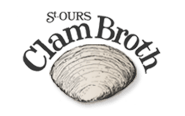All about fresh clams
First, clams should be alive and smell fresh. Lightly scrub the clam shells to remove any dirt. Discard any clams that are cracked, or that do not close their shells tightly. Soft shell clams have a neck, or siphon, and when touched it should retract back into the shell. Clams live in the bottom of the sea so they often have sand in their bellies. To remove this, soak clams in salted water (use 1/3 cup of salt per gallon of cold water). A twenty minute soak just before cooking is sufficient for them to siphon in the clean water and push out the sand. Lift the soaked clams out of the water rather than pouring them out as you don’t want to pour the sand sediment back onto the clams. Serving Size varies, when buying fresh clams, the size of the clam will affect the yield, but in general 1 lb. of clams in-shell yields about 4 oz. of clam meat so plan on 1 lb. of shell clams per person.
To Steam Clams
Use a large pot with high sides. Add about 1 inch of water. Cover and bring to a boil. Add cleaned clams to the pot carefully to avoid breaking the shells. Steam them for about 5 minutes or until the shells open. Gently stir them, remove clams as they open. Do not overcook them as it will make the meat tough. Discard any that do not open after about 8 minutes.
Soft Shell Clams
Soft shell clam shells are not really soft, but are thin and brittle. These are not usually eaten raw. We call these clams steamers. They are the best clams for steaming and for frying. They are harvested mostly on the Atlantic coast from Maine to Maryland but can also be found in Canada, the UK, and the coast of France. These clams are best eaten the day they are purchased as their shells do not close completely and they will dry out if kept too long, but they can be stored for up to 24 hours in a refrigerator covered with a damp towel. Remove the dark covering of the neck, or siphon, before eating the cooked clam. Try our Steamed Clams recipe or just swish them around in warm clam broth to rinse, and dip in melted butter. Yum!
Hard Shell Clams
Hard shell clams are called quahogs, commonly named and sold by size. Littlenecks are the smallest and are eaten raw on the half shell, fried, or steamed. This is the best size for recipes that call for whole, in-shell clams like our Spanish Paella, Cioppino, or Clam and Green Tomato Risotto Recipes. On the West Coast you can use Manila Clams or Washington Steamers. You can also substitute cockles which are widely available. Cherrystones are the next biggest size and are great grilled, broiled, chopped for chowder, or baked. Large quahogs are used for stuffed clams, chopped for chowders and stews, or used in any of our recipes that call for chopped clams.
Eating and Storing Fresh Clams
To use this fresh clam you can steam shuck them (steam until the shell is slightly open, about 2 minutes, then remove the meat, chop and set aside), or have your fishmonger shuck them for you, just be sure to reserve the liquor, which is the natural liquid inside the fresh shucked clam, to add flavor to your recipe. Raw or steam shucked chopped meat should be added during the last 5 minutes of the simmer stage for chowders. Since the hard shell clam can close its shell completely, they store longer than their soft shell cousins. Keep them covered with a damp towel in a bowl in the refrigerator until ready to clean and cook, no more than 1 week.
How to cook canned or frozen clams
While local, seasonal clams are always the best, the following options are convenient and available year-round.
Frozen Clam Meat
Frozen clam meat is available pretty much anywhere. When you buy frozen, chopped clam meat it is most likely the versatile surf clam. This giant sea clam is too large to be eaten whole, but almost every part of this clam is utilized, including the shells which are ground and sold as landscape material! Parts of this clam are also breaded and sold as clam strips. The meat has a delicate briny flavor and has a nice chewy texture. You can add these to your recipe frozen or thawed. If they are added frozen, increase the cooking time until the clams are cooked through.
Canned Clams
Canned chopped clam meat is also readily available in a variety of sizes. Drain and rinse the clam meat before adding them to the recipe. Do not use the juice from the can, use our clam broth instead!
Clams Serving Size
For most recipes allow 1/4 to 1/2 cup per person. One 6.5 oz. can of clams yields about ½ cup of clam meat.
More questions about clams? Email us at email@saintours.com or call us at (781)331-8520


